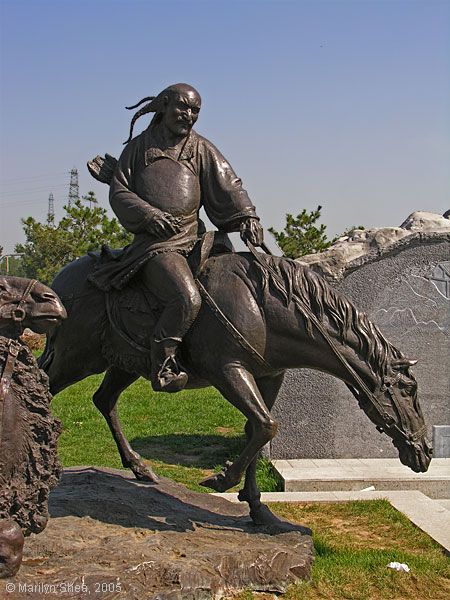 |
| Genghis Khan spent his youth learning to build and force alliances among the different Mongol peoples. His father had been a minor Khan who had been poisoned by Tartars, a rival Steppe people. That left Genghis Khan and his family destitute. There was no social security in those days, and the family was left in poverty with no position. The hard realities of his early teens taught him great lessons in both privation and leadership.
When he had amassed an army forged from the best of the warrior class of the Mongols, he began his campaign to make the Mongol people some of the richest and most powerful on earth. At least that's how it looks when we look back. More probably, he first set his sights on the Western Xia as a source of good grazing land, plentiful water, and access to the lands beyond. In 1206, he attacked the Western Xia, and by 1209 had defeated them. He had learned how to attack well defended cities in the process. It took a few years to coalesce his territory and incorporate Xia soldiers into his own army, but by 1211 he was ready to attack the Jin Dynasty. The battle took place at Badger Pass. A Jin emissary had betrayed the position of the Jin army and the Mongols won a decisive victory, decimating the Jin army. The Jin warriors didn't give up easily. It wasn't until 1215 that Genghis Khan was able to besiege and then plunder Yanjing (Beijing), the Zhongdu capital of the Jin emperor. The Jin Emperor Xuanzong 宣宗 (Xuānzōng), who had the misfortune to reign from 1213 to 1223, retreated to Kaifeng and reassembled his armies. Genghis Khan left the pursuit of the Jin armies to Ögedei Khan and his generals and turned his attention to expanding his territories westward. Genghis Khan died in 1227, so his heirs were left to finish what he had started. Emperor Xuanzong's successor, Emperor Aizong 哀宗 fought hard. The Jin warriors were skilled, but outnumbered. The Jin would not be defeated until 1234. As the Mongol armies were closing in on the headquarters of the Jin, Aizong 哀宗 abdicated and asked one of his generals to be the emperor. He agreed and was made Jin Emperor Modi 末帝 (Mòdì). The next day the Mongols broke into the city walls and he was killed. The outcome was expected. The reign name he had chosen for himself means: 末 Mò "last"; 帝 Dì "emperor." He had the shortest reign of any emperor in history. Once the Jin armies had been put out of the way, the Southern Song Dynasty stepped in to reclaim Kaifeng, Chang'an and Luoyang. That was a mistake. The Mongols had not fought for the benefit of the Song Dynasty. Although the Mongols had had an alliance with the Song, this was a perfect reason for an attack. First Möngke Khan in 1259, and then after his death, Kublai Khan, led the Mongol armies against the Song forces. It was a long war. In 1271, Kublai Khan declared the Yuan Dynasty 元朝 (Yuán Cháo), but it wasn't until 1279 that the Song were totally defeated and the last emperor committed suicide. Even before declaring the Dynasty, in 1266 Kublai Khan ordered the construction of a new capital at Yanjing, or Zhongdu, the middle capital of the Jin Dynasty. The Yuan capital would be called Dadu; "Great Capital." He moved the center of the city to the north of what is now Tian'anmen Square. He wanted to take advantage of water features available there to incorporate lakes and rivers into the design of the palace and the city. It was a walled city, and much larger than the Jin capital had been. Just as the city construction began in 1266, Marco Polo's father and uncle were invited to meet Kublai Khan in Dadu. It was because of requests made by the Khan that the pair returned to Venice. Kublai Khan was curious about many of the things he had been told about foreign lands and wanted more information. In 1271, the Polo family began their journey back to China, this time with Marco in tow. Some years after that, they finally arrived back in Dadu and Marco Polo met the Khan who was by then the second Yuan emperor of China. (He had declared his grandfather, Genghis Khan, as the first emperor of the Yuan Dynasty.) Kublai Khan sent the Polos on several missions to explore territories. It was on one of these tours in 1276 that Polo detailed his exit from Dadu, which he called Cambaluc. He described the bridge he used to cross the Pulisanghin river to the west. Historians deduced that he crossed using the Lugou Qiao. |
http://hua.umf.maine.edu/China/beijing2.html
Last
update: October 2009
© Marilyn Shea, 2009